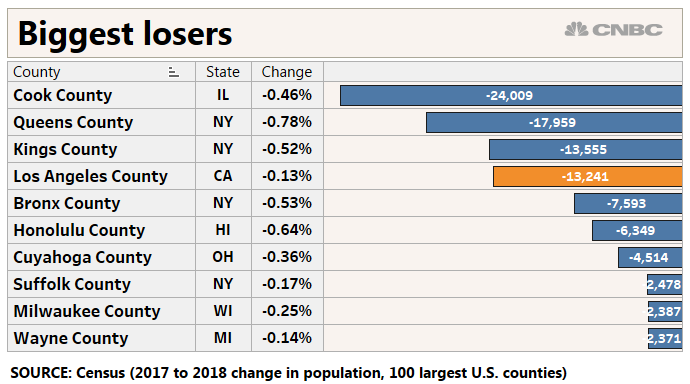The County of Los Angeles’ population fell last year, even as other major counties in the state added residents.
“Los Angeles is just not growing,” said Richard Green, director of the University of Southern California’s Lusk Center for Real Estate. “A lot of [the reason] is housing, and not just the cost of housing but the number of houses that are available. Vacancy is incredibly low.”
Los Angeles ranked fourth in terms of the nation’s most populous counties losing people in 2018, according to new estimates by the U.S. Census Bureau. It comes as the Los Angeles basin struggles with housing affordability and the lack of new home construction.
The government’s data, released April 18, shows the population in the County of Los Angeles decreased by 13,241 residents as of July 1, 2018, to 10.104 million people. Counties that lost more people in 2018 were Cook County/Chicago in Illinois as well as Queens and Kings counties in New York.

“There are big urban core counties across the country that are either losing population or gaining fewer people than they had 3 or 4 years ago,” said William Frey, a demographer for the Brookings Institution. He said that’s a reversal from earlier in the 2010 decade when big cities and large metropolitan areas were growing faster than suburbs.
According to Census data, just over 26% of the 360 metro areas within the U.S. showed population declines in 2018. It said areas with the fastest decreases were due mostly to negative net domestic migration.
Even though Los Angeles County lost residents, the new Census data shows California added 157,696 residents statewide in 2018, reaching a population of 39.557 million.
San Diego County — California’s second-largest county, with a population of 3.34 million people — added nearly 17,896 people in 2018, according to new Census data. Also, major counties in the San Francisco Bay region grew slightly in population in 2018, including Alameda (8,622 new residents), Contra Costa (5,352) and San Francisco (4,139).
Los Angeles and other California metros increased in population in the 1980s due in part to international immigration from Latin America and Asia. Even though that growth slowed substantially by 2000, new arrivals in the past five years have only added pressure to the state’s tight housing market.
The housing situation in Southern California is especially tough for lower-income residents. About 7.5 million people live in poverty in California, including about 15% of the population of Los Angeles County.
USC’s Green said there has been a spillover of Los Angeles residents moving into nearby Inland Empire counties, such as Riverside and San Bernardino. “You have all these people competing for housing, and there’s just not enough of it,” said Green.
Census data shows the Inland Empire region added more than 50,000 residents in 2018.
According to Rentcafe, average rents in Los Angeles County are $2,371 a month, up 7% from a year ago. That compares with average rents of $1,229 in San Bernardino County and $1,528 in Riverside County.
Also, Riverside and San Bernardino counties have become distribution hubs and locations for large fulfillment centers operated by Amazon and other companies. They have added thousands of new jobs in the past decade to the Inland Empire area and fueled more housing development.
“We’ve seen more jobs move east to Riverside and San Bernardino counties,” said Green. “They will become increasingly more important centers of the regional economy.”
— Graphic by CNBC’s John Schoen.

